|
|
Dear Wisconsin beekeepers and those interested in honey bees and wild pollinators:
This is the fourth quarterly update of 2022 from the Wisconsin Department of Agriculture, Trade and Consumer Protection’s (DATCP) apiary program. Please let us know how you use this newsletter and send any feedback, questions, or ideas for future updates to frances.hegarty@wisconsin.gov.
|
|
|
The Honey Bee Health Coalition updated its Varroa management guide for 2022.
On their Varroa management webpage, click on “Discover more” and navigate to the Varroa management guide for the downloadable PDF. Their Varroa management decision tool is also helpful, including a walk through of Varroa mite management decisions.
Varroa mites are aggressive external parasites that feed on honey bee brood and adults, weakening honey bees, and spreading multiple viruses. A honey bee colony’s Varroa mite population may seem low early in the season, before spiking shortly after brood and adult honey bee populations reach their peak. Therefore, it is very important for beekeepers to take Varroa mite counts from colonies monthly during the bees’ active season and record that data. Varroa mite populations can spike very quickly, overwhelming honey bees. If untreated, Varroa mites can kill the honey bees in a colony. The updated Varroa management guide describes Integrated Pest Management (IPM) as “a set of proactive, control methods that offer beekeepers the best 'whole systems approach' to controlling Varroa [mites].” Follow the instructions in the guide (including the video). With the IPM and Varroa mite counting instructions, you can create, use, and adjust a Varroa mite IPM plan that meets your needs to manage this harmful pest below damaging levels.
While the guide includes two Varroa mite monitoring methods, the most accurate method is the alcohol wash method (or non-sudsing soap or automotive windshield washer fluid with at least 40% alcohol). Learn more in this video. The alcohol wash method requires killing about three hundred adult bees, but this is justified because Varroa mites are ubiquitous and very harmful to honey bee populations if left unchecked. However, the beekeeper must verify that the queen is not present in the sample. Despite the fact that each colony of honey bees contains tens-of-thousands of honey bees in the summer, allowing bees to become hosts for Varroa mites increases the chances of wintertime colony losses. A beekeeper should know their Varroa mite levels throughout the season to make informed choices about their honey bees’ health, including when to apply pesticides to treat for Varroa mites and when to use preventative (non-chemical) control methods.
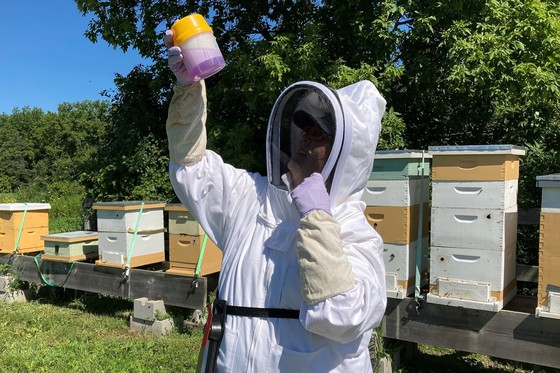 Photo: DATCP apiary inspector conducts an alcohol/ soap wash Varroa mite count.
|
|
|
You can now send the honey bees left over from your Varroa mite alcohol wash samples to Purdue University for a genetic test for Defensive Honey Bees (aka Apis mellifera scutellata, Africanized honey bees, or 'scutellatized honey bees'). The genetic testing for defensive honey bees relies on whole-genome sequencing using mitochondrial DNA (mtDNA and gDNA). Each submission will take about 4 – 8 weeks to complete after which you will get a report on the ancestry of your honey bee sample. The honey bee ancestry plot is made by comparing the genomes of your sample to standards of known origin and asking how ‘related’ your sample is to the known.
Beekeepers in the Americas used honey bees from European lineages until 1956 when a population of Apis mellifera scutellata was moved to Brazil and mixed with local populations of honey bees, escaped, and moved into Central and North America. This invasive population is called defensive or scutellatized honey bees, but they have also been referred to as ‘killer bees’ or ‘Africanized honey bees’.
Brock Harpur’s lab at Purdue University (and Andrew Patterson of the University of Georgia) have funding to test about 100 samples from each US state at no-cost for you. So far, they have not received any samples from Wisconsin, and request that you send the honey bees left over from your Varroa mite alcohol wash sample to take advantage of this free genetic testing. They are interested in receiving honey bees samples from Wisconsin that have not been recently imported from another state that has been marked red on this map. If you are interested in this genetic testing, email honeybee@purdue.edu for instructions and the sample submittal form.
Samples sent to Brock Harpur’s lab for defensive honey bee genetic testing that are outside of the project (100 sample per state) mentioned above will cost $85 per sample. If you decide to send in your bees for genetic analysis, please consider sharing the results with DATCP, to help us get a better handle on bee ancestry in Wisconsin.
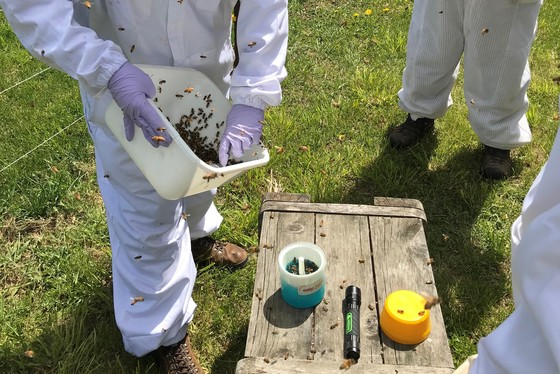 Photo: DATCP apiary inspector conducts an alcohol/ soap wash Varroa mite count.
The U.S. Department of Agriculture's (USDA) Farm Service Agency (FSA) has disaster assistance programs that, depending on the specifics of each case, may be able to provide financial assistance to qualified honey bee or honey producers experiencing losses. See the fact sheets listed under Bees & Pollinators at https://www.fsa.usda.gov/news-room/fact-sheets/index.
Unique reporting requirements apply to beekeepers. Beekeepers interested in participating in the ELAP or NAP programs should contact the FSA office where their farm records are maintained, in advance of the reporting year, for more information about specific reporting requirements. Colony reports are due by January 2 each year for upcoming year. Any time beekeepers acquire additional hives or move hive locations they will need to report these changes to their FSA County Office within 30 calendar days to maintain eligibility for ELAP and/or NAP.
For more information these programs, visit https://www.fsa.usda.gov/news-room/fact-sheets/index or contact your local FSA office.
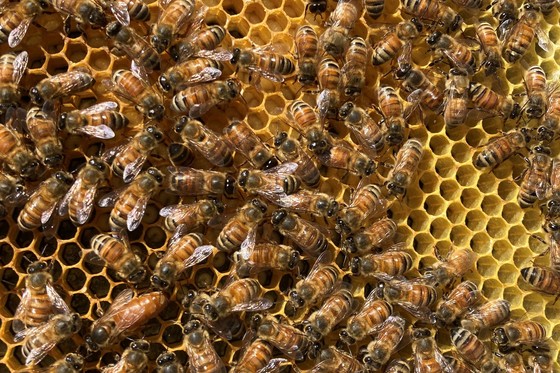 Photo: Honey bees (and the queen bee, in the lower left corner) on comb.
|
|
|
While honey may be considered a safe food, it is still important to process and handle it in a sanitary manner. You may need a license to process honey if you receive it from apiaries other than your own, or if you whip, add flavors to, or otherwise process your own honey beyond bottling. Licensing contact information can be found at DATCP’s licensing webpage or by calling (608) 224-4923.
Grading is based on the type of honey: comb honey, cut comb honey, chunk honey, or extracted honey. The grade is determined by the weight of the honey, odors, bubbles, honeydew, and clarity to meet the definitions provided in Wis. Admin. Code §§ ATCP 87.04 - 87.08. Honey grading is optional, but if it is not graded, the label should state that it is “ungraded.” The label may also contain the USDA grade in addition to the Wisconsin grade, which can be obtained at the USDA website.
Producers may choose to participate in Wisconsin’s certified honey program, which allows them to use “Wisconsin Certified Honey” on their label if they have approval from DATCP. Honey is tested by a certified lab to meet parameters as outlined in Wis. Admin. Code § ATCP 87.017, and results are submitted to DATCP with the application and $50 fee. Approvals expire at the end of odd-numbered years.
More information can be found at DATCP’s selling honey in Wisconsin webpage.
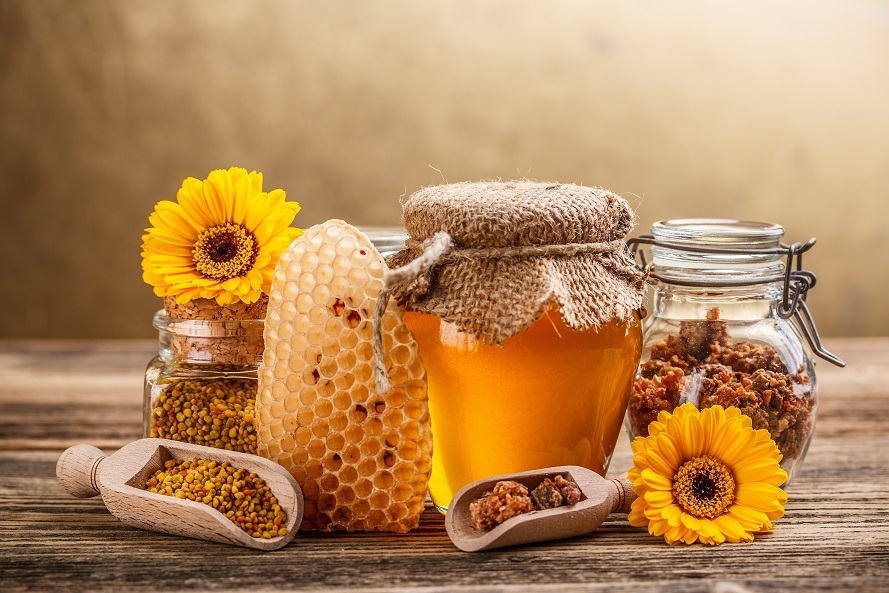 Photo: Honey bee products include, from left to right, pollen, wax, honey, and propolis.
|
|
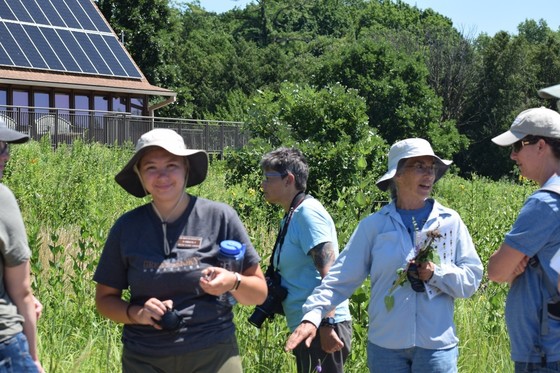 Bumble Bee Brigade training at the UW Arboretum, 2022.
Did you know that Wisconsin has more than 400 native species of bees? Twenty of these bees are bumble bees, and they could use our help! Anyone across Wisconsin can help protect bumble bees by taking photos of bumble bees and sending them to the Wisconsin bumble bee brigade website here: Wisconsin Bumble Bee Brigade (wiatri.net). The website includes resources on the life cycle and how to identify these amazing creatures. The data will be used to help get funding to maintain and improve pollinator habitat and better manage lands.
Quick tips include:
- Food -- Plant a variety of flowers that will bloom throughout the growing season. Native perennials like Dutchman's breeches, bee balm, and asters are especially well suited to support bumble bees, which have long tongues and can't see the color red.
- Homes -- Bumble bees nest in the ground, so leave brush piles and sandy open patches to provide nesting habitat.
- Water – Bees need to drink too! Ponds, streams, or even a birdbath with a few stones will help them stay hydrated.
More resources for planting for native bumble bees can be found here: https://dnr.wisconsin.gov/topic/endangeredresources/pollinators.html.
|
|
|
|
|